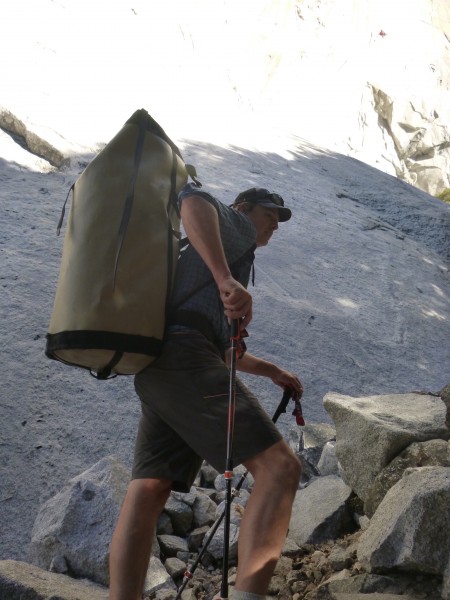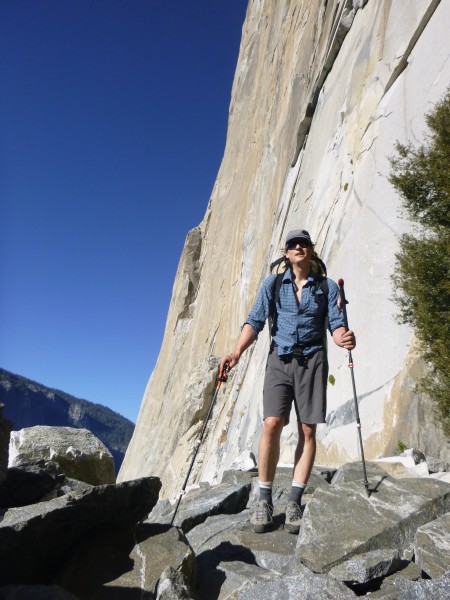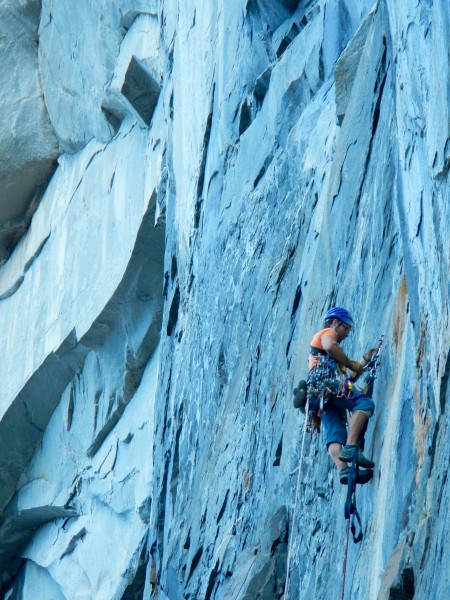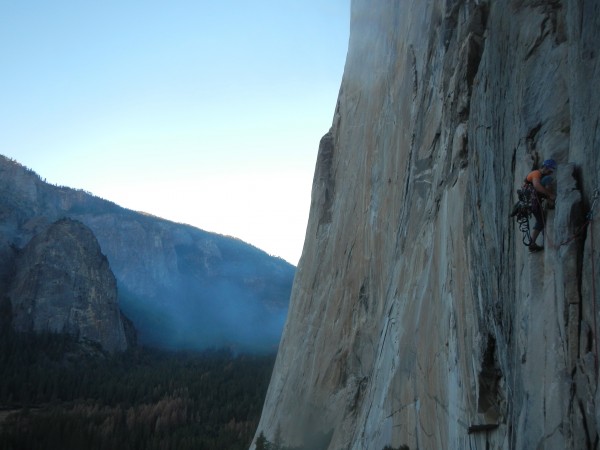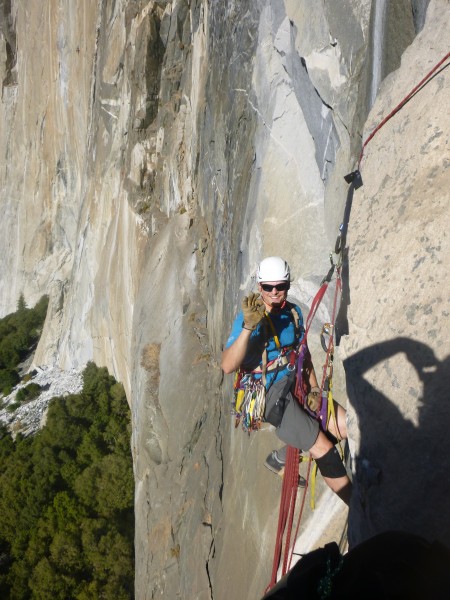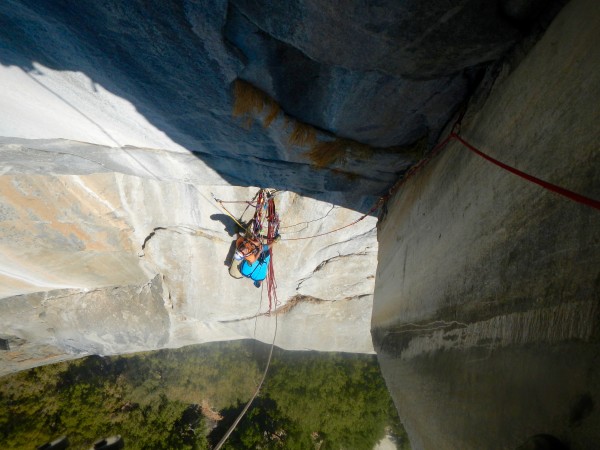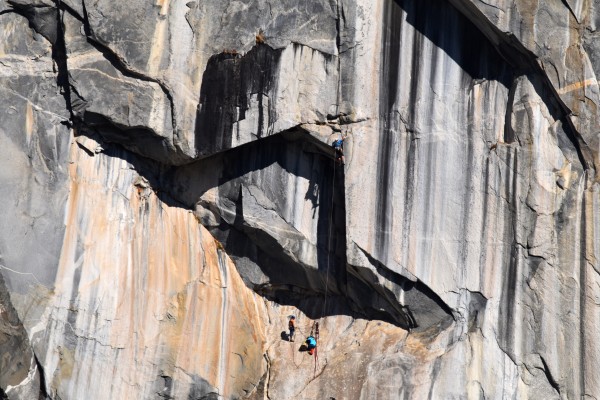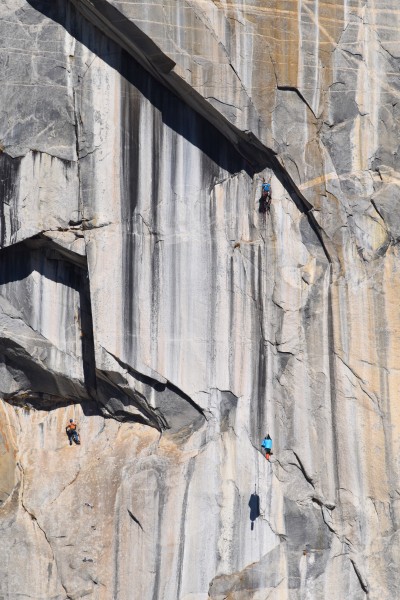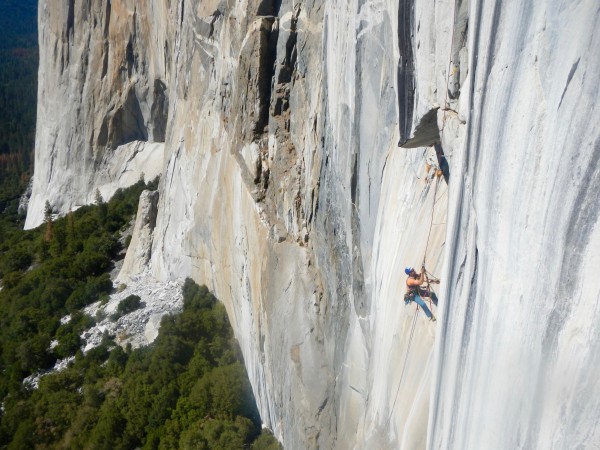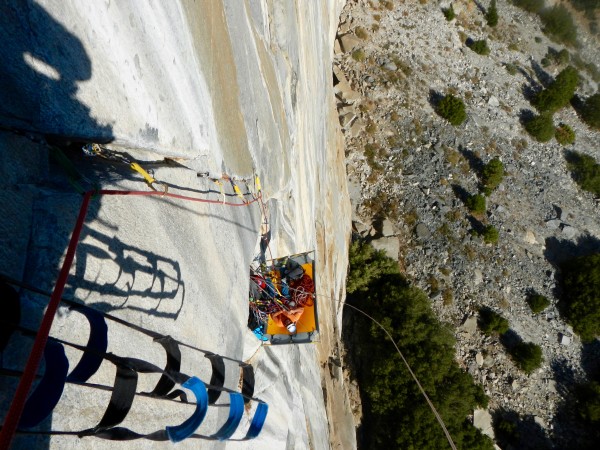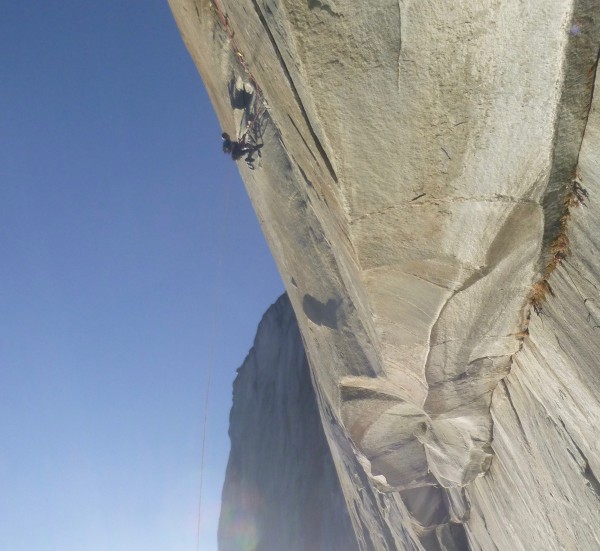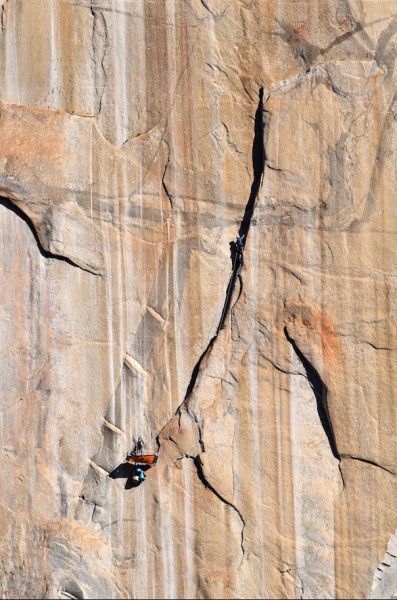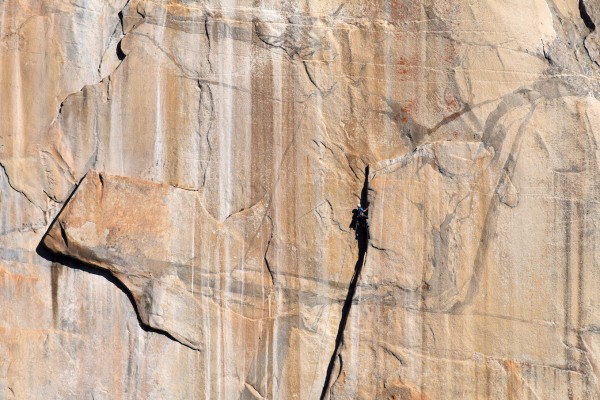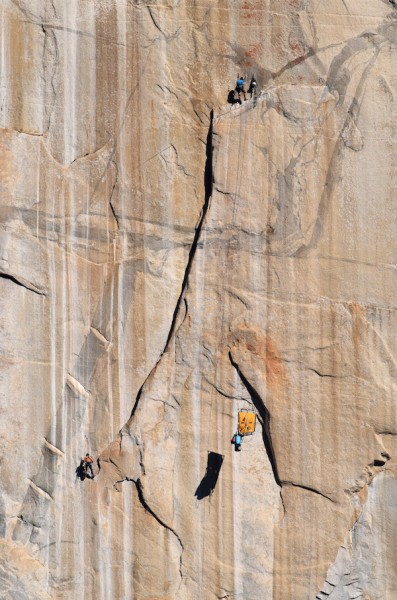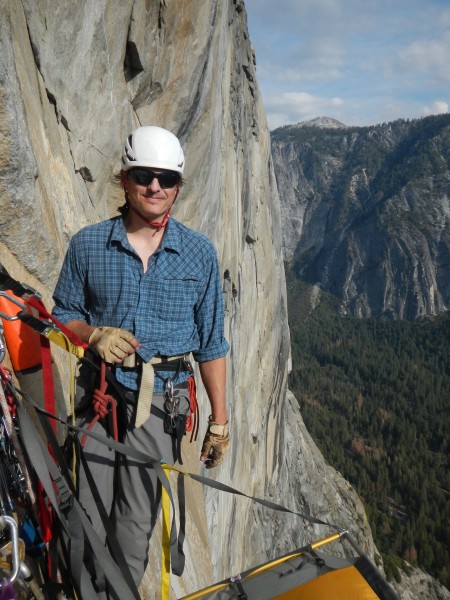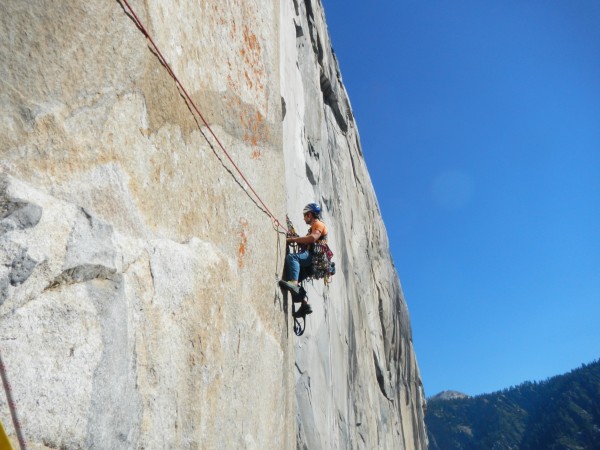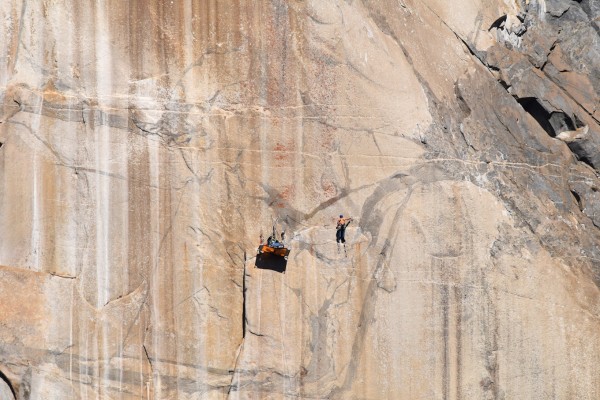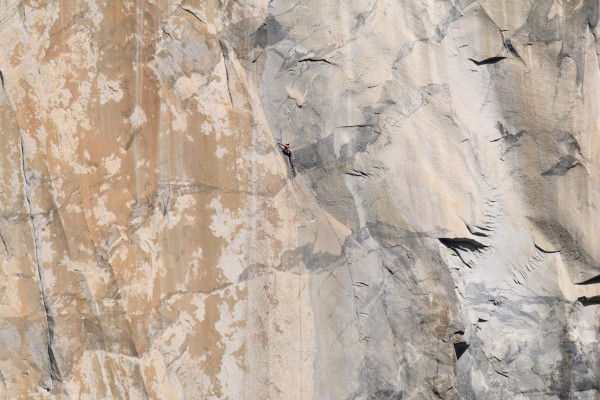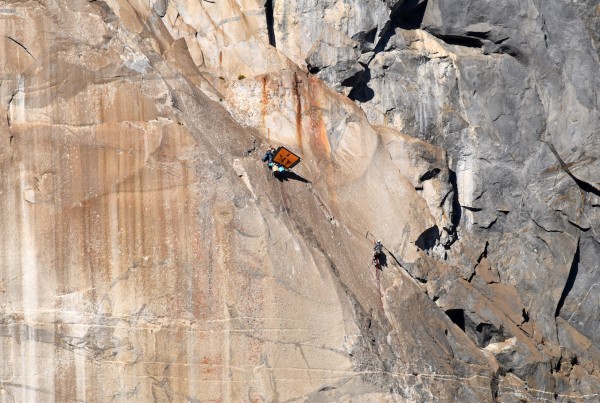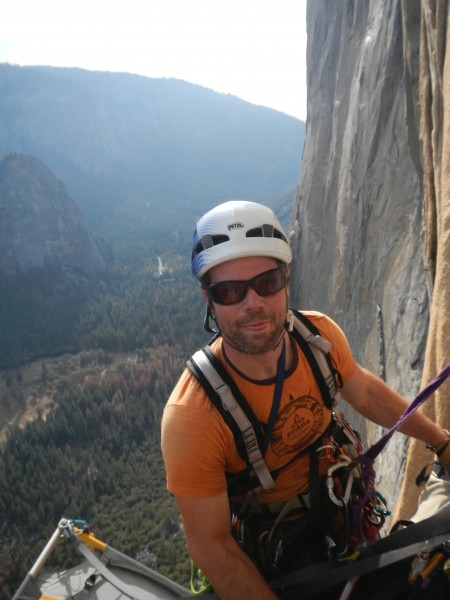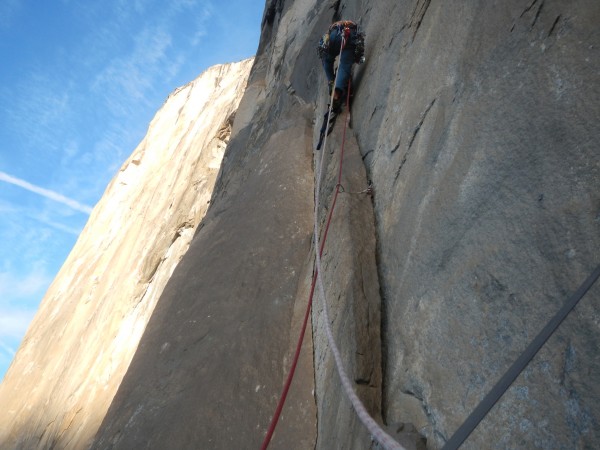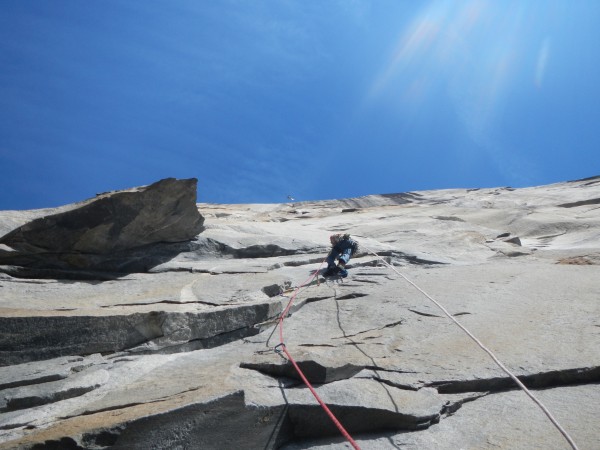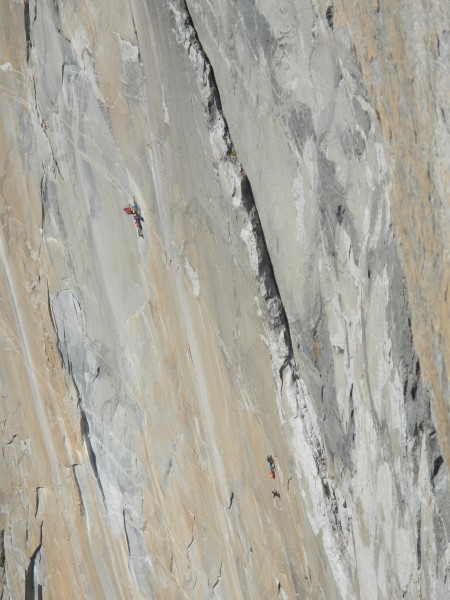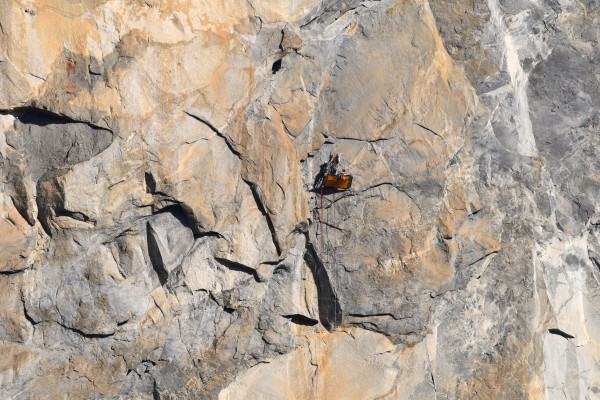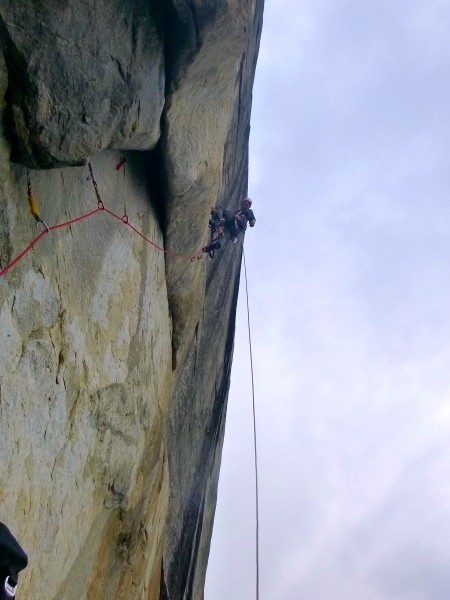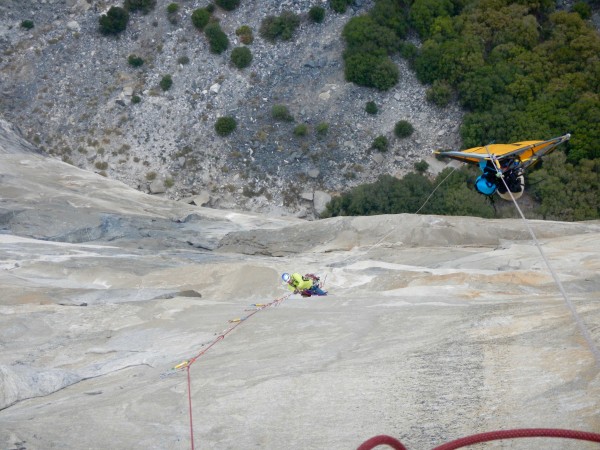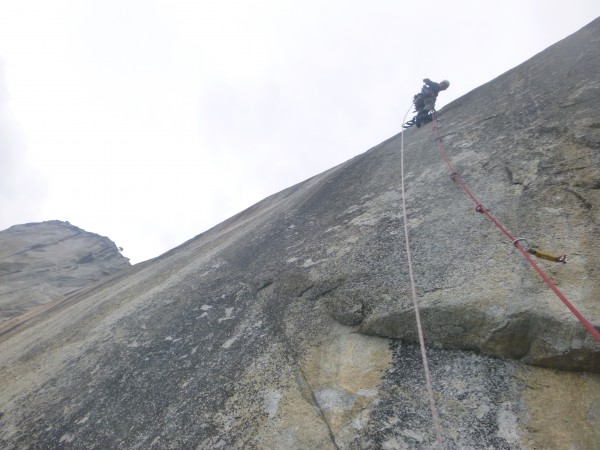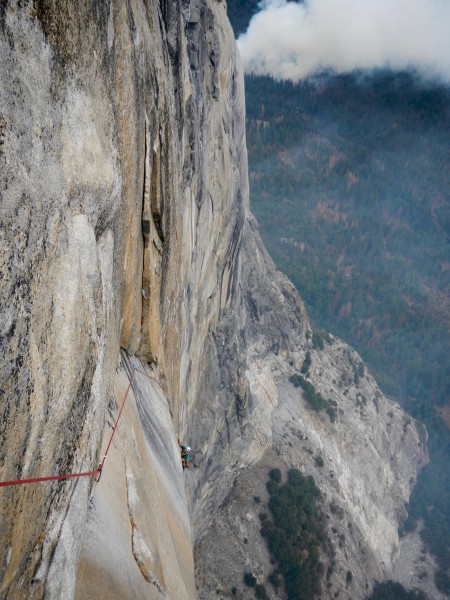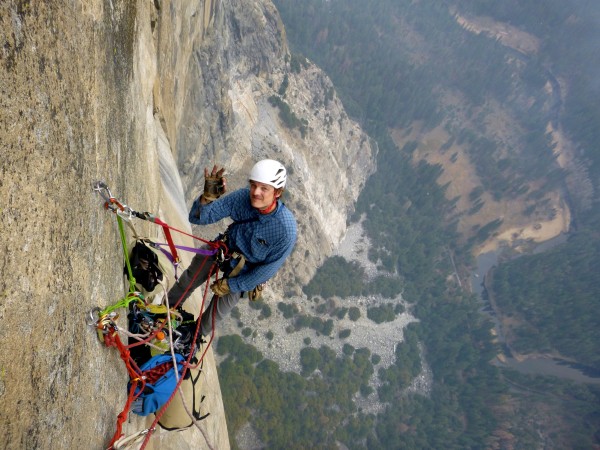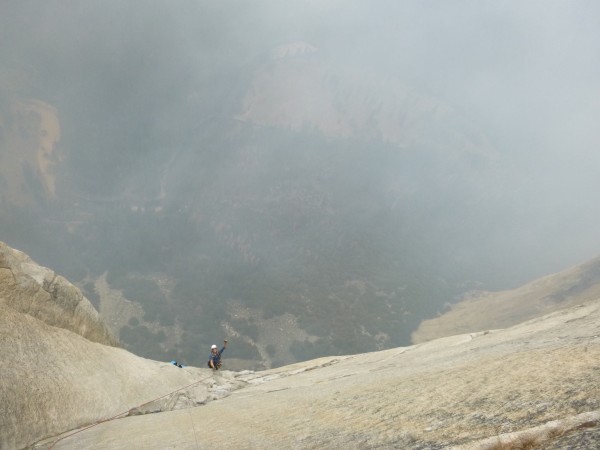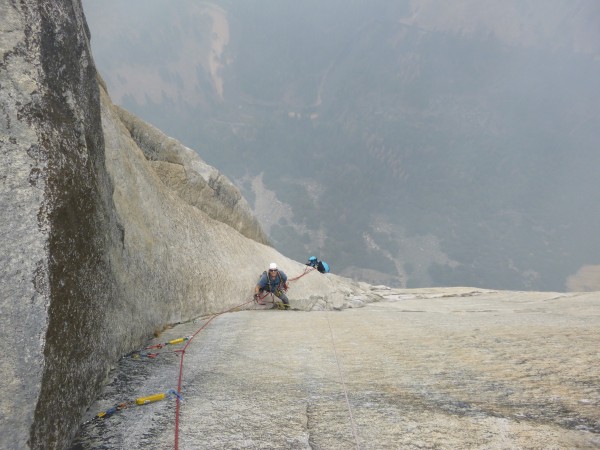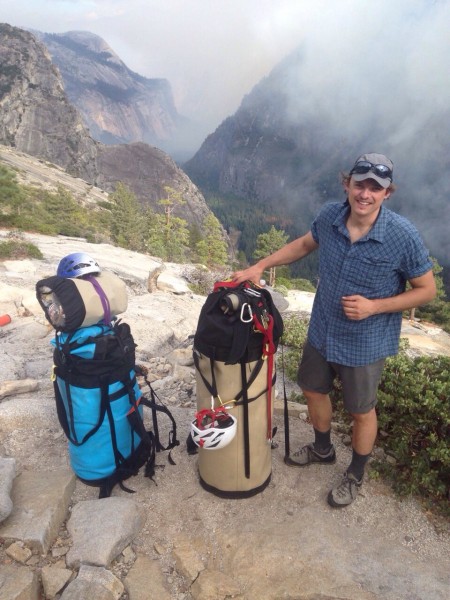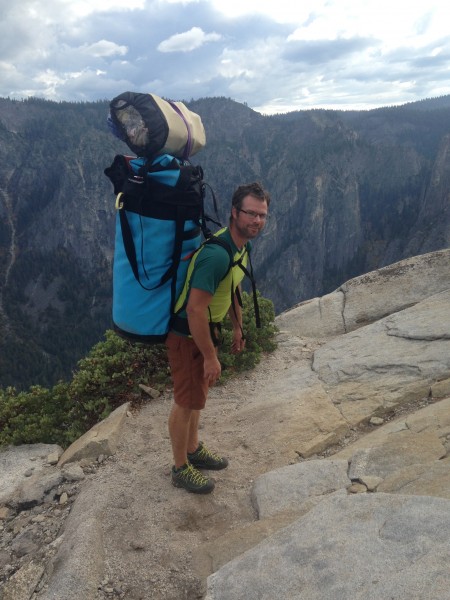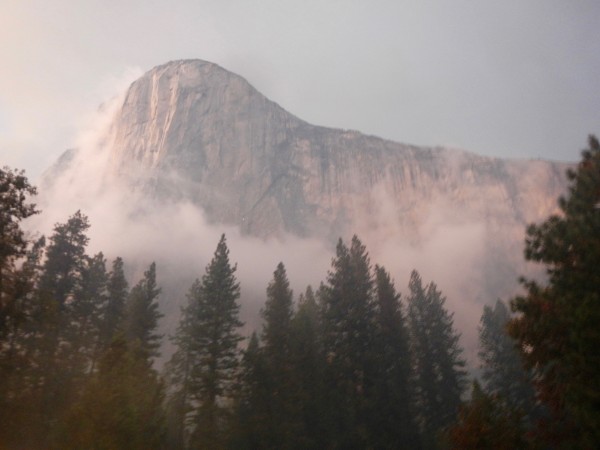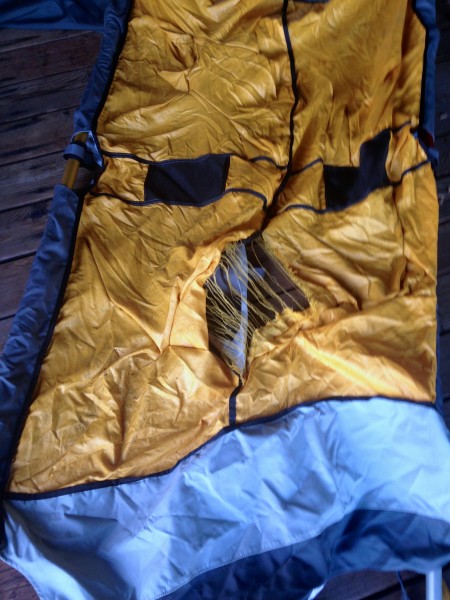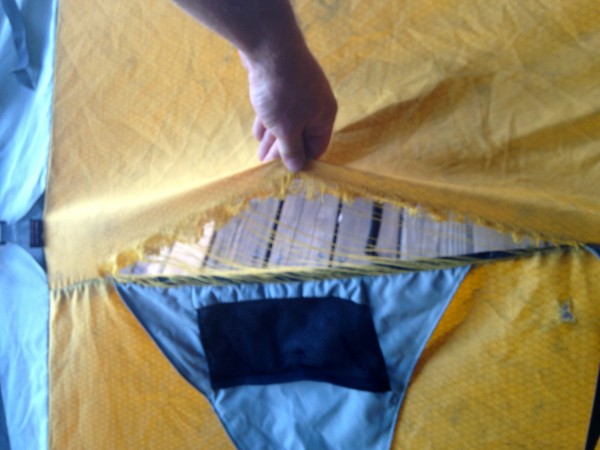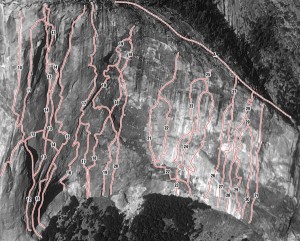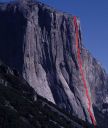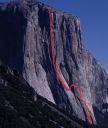October 2015: Due to time constraints Ryan O'Connell and I flew down from Seattle to Sacramento and rented a car. We had always driven down in the past, but since both of use didn't have a lot of time we decided to fly-down instead. This worked surprisingly well (maybe that's obvious to others); after we flew down, bought all of our food in Sacramento and drove to the Valley. We left Seattle on like a 6am flight and rolled into the Valley in the early afternoon, having already bought all of our food.
We hiked our loads to the base of El Cap, we originally wanted to climb the North American Wall, but with two parties on it, plus nearby Pass-the-Pitons Pete attempting what would be a 25 day ascent of Tempest, and Steve "Shapoopee" Schneider soloing Sea of Dreams, we opted for T-Trip which had no-one on it, at least that we could see. However upon our arrival at the base of the Trip there was another party just starting up. This helped prompt us to take a rest day between hiking loads and "blasting off". I have never actually waited a day between hiking-and-blasting off before, but now I think its the way to go. After traveling down there and hiking loads, taking a whole day off just let us recharge our batteries and only increased our stoke to climb El Cap.
After our rest day we hiked up our food and the last of our water, before fixing the first pitch. We slept at the base with the plan to "blast-off" in the morning. The alarm went off at 5:30am and it was still dark. After some breakfast pastries (AKA fancy Pop Tarts) we each traded off jugging the free-hanging line we had fixed the night before.
I reached the top of pitch one first and self-belayed while Ryan took his turn on the free hanging jug. For me it was rather easy to "short-fix" this section because it started mostly with easy mid-5th class climbing and plenty of places to stand and feed slack through my GriGri with two hands.
We also derived a system of leading and following on Tangerine Trip. In the past the two of us just sort of "winged-it" and whoever felt the most stoked would basically lead the next pitch. This time however; we decided on a more systematic approach to split the workload. Our plan was that we would try to climb 4-pitches each day; with Ryan and I each leading 2-pitches in-a-row each day. This way one person would basically have the morning off, and one person would have the afternoon off.
The Chris Mac's SUPERTOPO guidebook talks about belaying ~30ft higher out on the face above this corner where this photo is taken. This certainly offers the leader less rope drag, but Ryan was nice enough to let me "stand" on this small ledge, something my hips certainly appreciated.
The lowest part of the wall is steep, but this is were the route gets radically STEEPER. I watched as Ryan aided up marginally tricky C2+ to get to the base of the roof. He didn't have to place much of his own gear on this pitch, especially the second half. This is because most of the section straight down below the roof has a ton of fixed gear, to bad it was such terrible mank.
After a mix of tensions, down aiding, and pendulums Ryan reached the belay at the top of pitch-4. The wall was so steep the tensions/pendulums were slightly tricky because once I lowered him, his feet could only barely touch the wall. We did learn that pendulums were the key and fully the way to go (compared with down aiding) and he placed very little of our own gear. He would just swing hard, clip the fixed gear (then often back-it-up) and then lower and swing hard again to the next piece.
The Wall was soooo steep here, I jugged up through the steep corner above the belay and was amazed at how poor so much of the fixed gear on this section was. It wasn't as bad as the Shield's Groove pitch, but it was pretty bad.
I've done a lot of tricky cleaning on ascenders before but cleaning the downward traverse on pitch four certainly got my attention. All the gear in the downward diagonaling roof was soooo manky looking and if it popped I was looking at an epic swinging leader fall onto my ascenders.
As a result down-jugging the roof was one of the spicier and more physical big-wall following experiences I have ever had. I've jugged a lot of tricky-to-clean pitches, but these lower-outs were so long, I'd just lower back-out into space, pull the backside of my rope through the fixed piece and again jug free-hanging-in-space back up to the next piece, it was SUPER physical jugging and dare I say straight-up burly. I could certainly feel my biceps, particularly might right one when I reached the belay and was stoked that Ryan was leading the next pitch which had the reputation of being the crux of the route.
We set the portaledge up which would make our belays for the next few days far more comfortable. Ryan took off up the overhanging and very diagonalling pitch. It was quite physical for him as the wall leaned away almost like a crashing wave in a sea of granite.
After our night at the top of Pitch-5 we woke up to find a nearly three foot long tear in the bed of our portaledge (I know right). This would actually get worse each night and the tear begin ripping out on both sides of the outside sleepers "bed".
Ryan woke up the next morning and despite having holes in the portaledge on either side of his torso, stoked and ready to go. He quickly racked up like a boss to lead the next two pitches (6 and 7).
The next pitch was the other "crux" (as it was the only other pitch rated C3 on the Trip) pitch and we wondered how it would go. Since Ryan lead pitch 5 hammerless I left the hammer in the bag and hoped for the best.
The start of pitch 8 is a little funky traversing section out to the edge of a very narrow ledge to reach the first bolt. The bolt is pathetically close as you teeter on this narrow little ledge. It looks so easy, and was hardly
difficult, but Ryan laughed as it took me a moment to reach the bolt.
I was so thirsty when I arrived at the belay I hauled as quickly as I could just to get into the water. Despite my rope-drag wows I was happy I didn't have to nail on the pitch and was able to free-climb almost the entire C3 section at a fairly moderate grade (~5.10b?).
Luckily pitch nine went mostly into the shade. This pitch wasn't too bad to lead but I had to take a fair amount of care to protect Ryan while seconding on the mostly traversing pitch and still keep enough cams for me to lead it. I ended up back-cleaning almost the whole first half of the pitch so Ryan wouldn't have to do almost any tricky sideways jugging. There would have been several placements that would have been extremely difficult for him to clean because of the pitches traversing nature. It also saved me quite a few extra .75-3" cams which were super nice to have later on the pitch and we only brought a double set. Even then, I free climbed the final traverse to the belay and Ryan was more or less forced too as well. This is one of the spots where we had a small stance for us to help organize our belay, but halfway up the pitch there was a pretty baller ledge and we wished there was an anchor there.
Hauling pitch nine was also very tricky with the portaledge open. We actually moved the bags/ledge and retied them into the middle of the haul line. Once in the middle of the line; I hauled hard while Ryan tensioned/lowered the bags out to keep the portaledge from getting even more destroyed on the slopping ledge below the pitch. While this took a fair amount of effort it was successful in keeping the ledge from getting trashed. We spend then spent night on pitch nine which was a nice place to camp for the night. There is a small 1+ foot deep ledge to help set the bags on and stand while getting things organized.
The next day I had the morning leading block and lead up pitch 10 to start the day. It was longer than I expected and ate up so many small cams of all sizes. Near the top I even had to quickly lower back-down and back-clean a handful of cams near the top just to finish the pitch.
Ryan took over for the afternoon leading shift on what was now our third day of the route. Here he is leading pitches 12 (pictured above) and 13. Pitch 12 went quickly for him, it was a little tricky right off the belay but then that lead to a long rivet/bolt ladder which he cruised.
The second half of pitch 13 offered a fair bit of mellow free climbing but there is certainly some loose rock. Its worth-it to wear rock shoes for this pitch and we spent the our third-and-final night at pitch 13. We knew there was a chance of rain in the forecast for the following day so we wanted to sleep at pitch 13 which was completely sheltered in the event of rain (its under a HUGE roof). That evening there was a fire that started down valley near Curry Village and with the small amounts of rain we received overnight made the valley incredibly smokey in the morning.
We woke up in the morning to find the smoke thickening as the fire had gotten worse and the light intermediate rain only adding to the problem. Ryan lead off and the start of pitch 13 proved awkward with good, but hard to place pieces deep in the back of a traversing flair. To motivate us to get off the wall that day even more were the portaledge tears which were getting boarderline ridiculous and with light drops of rain starting and stopping we knew we had to get off the wall today.
Ryan cruised past the flare, and sprinted up the bolt ladder for 160ft to the next belay. The bolt/rivet ladders that are plentiful on the route do take a little away from the quality of the over-all climbing, we both still thoroughly enjoyed "The Trip".
We both talked about what would happen if it starting raining harder (as luckily with the latest forecast wasn't supposed to start now until that afternoon....) Could our portaledge really survive one more night. Ryan would actually "Sway" in the breeze because he was now only suspended like a hammock from the ends, (Yikes is right!!!)
Ryan lead pitch 15 which started with a bolt ladder to some funky moves before the route traversed slightly to the left. He took a while placing a few small pieces and then before I knew it; I just heard him flying through the air and I felt the strong upward tug of the rope!!!
Ryan had pitched off and blown a cam he was standing on. He partially flipped over and even gave himself some rope burn. He fell about 20ft, hung for a moment, and then
Bat-manned his way back up the rope. I was impressed with Ryan; he slowed only slightly while he replaced the pieces that had pulled during his fall, but then took off again very efficiently making over-all quick work of the pitch. I meanwhile changed from cotton into capilene as the rain drops began to fall a little more frequent and a little heavier.
Ryan reached the top of pitch 15 and quickly shouted that he was off belay. I sucked-it-up, my strained biceps hurt and I attempted to jug the pitch as quickly as I could. About halfway up the pitch the angle of the rock flipped over and I could stand in my stirups again taking a tremendous amount of weight off my arms. This re-energized me and allowed me to make very quick work of cleaning pitch 15's traverse.
At the top of pitch 15 Ryan and I packed up the portaledge. The rain was getting a little more frequent but there was enough sun poking through to keep the C2 Hooks and 5.7R that started pitch 16 dry. The 5.7 R really wasn't bad at all. The protection was poor but the climbing was more secure than I expected. It wasn't slabby/friction climbing at all. In fact it was near vertical but covered in nice edges as the beginning of the pitch started up a fragile flake that while difficult to protect, was pretty easy to climb. After the flake the pitch ended with a super fun corner that was mostly free climbing (easy 5.10) and C1 up a slowly steeping corner to one of the biggest ledges of the route.
Ryan jugged the pitch quickly now able to stand more on his feet as he ascended the rope. He wrestled with the haul bags several times, but couldn't stop smiling as we knew we were going to get off the wall today.
The final pitch was wandery 5.6R, but mostly 5.0 slabs. Rather than the climbing the greatest care was more to keep from knocking rubble down on the rock-strewn slabs rather than having to try hard not-to-fall. I climbed up over the final slabs to were the ground was flat and searched for the most bomber tree I could find. I had to flip the rope over several trees so Ryan would be able to jug straight up. This proved a marginally challenging task with all the loose rock just sitting on slabs.
Once on top we realized we had made excellent time up the last four pitches and made it to the top around noon. After four days on the wall, nothing feels more awesome than walking on flat ground and taking your harness off. We looked down and waved to my in-laws who had been watching the last few days from the meadow. We could see them and they waved back. I called my wife to say hello and we packed up.
Other than when I climbed the Nose-in-a-day, the descent off El Cap always sort-off sucks. Your bags are always heavier than you think and it always is slightly more tiring then you remembered. It was fun descending El Cap together for now the third time, we stopped and talked about were we had topped out previously and were we had bivied on top of the rappels after our first ascent of El Cap together, when we climbed Zodiac in 2006, on the slabs were the bolts are at the top of the first rap.
On our hike down the clouds got darker and darker and just as we hit the road it started pouring. I left Ryan and our gear at the parking lot while I jogged back to El Cap meadow in what was a full-on down pour when I arrived. Then the smoke got so bad, they closed the road and wouldn't let anyone drive because the visibility wasn't good enough. Eventually the rain lighted and the road was opened. What we both found interesting is now every time we have climbed El Cap together it has rained the next day.
